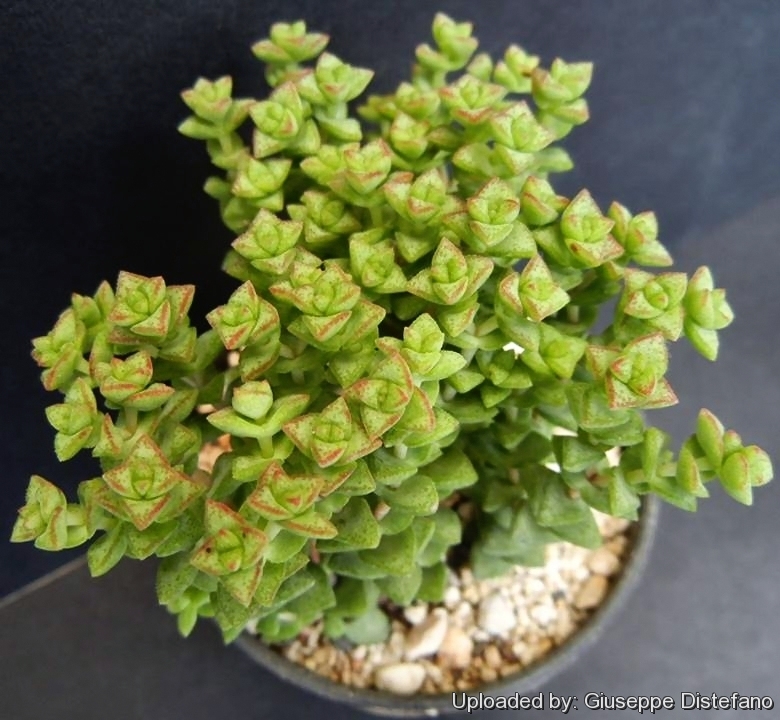




Your support is critical to our success.

Origin and Habitat: Garden origin, hybrid.
Synonyms:
ENGLISH: Tom Thumb
AFRIKAANS (Afrikaans): Klein Duimpje
Description: Crassula cv. Tom Thumb (syn. 'Klein Duimpje') is a miniature, pagoda-like branching crassula, that looks like a mini, compact 'Necklace' or Crassula perforata variety. Even though regarded as a common crassula, that does not prevent it from being one of the most exquisite. It originates from a chance cross between Crassula rupestrisSN|26789]]SN|26789]] (ssp. rupestris) and Crassula rupestrisSN|26789]]SN|26789]] ssp. marnieriana and was found by W. J. Ruysch, The Netherlands. When in flower the plant is is only 10-12 cm in height, but grows well and should prove an interesting and worth while addition to any crassula collection. Produces tiny heads of many mall star-shaped white flowers in winter if they are given proper conditions of temperature. There is also a variegated mutant called Crassula 'Pastel'.
Leaves: Tiny only about 5 x 4 mm, grass green, very thick and packed tightly in opposing ranks along the stem with the triangular tips outlined with a row of light maroon or red spotting especially in bright light. Internodes not visible.
Stem: Erect or semi-erect, wiry, thickly covered with leaves, 10-15(-20) cm tall and nicely branched.
Flowers: Tiny star-shaped, delicate, white, sweet-scented flowers appear in clusters at the top of the plant in winter.
Bibliography: Major references and further lectures
1) African Succulent Plant Society “The Bulletin of the African Succulent Plant Society”, Volumes 3-4 African Succulent Plant Society., 1968
2) Dave's Garded contributors “Crassula 'Tom Thumb'” Read more: http://davesgarden.com/guides/pf/go/96516/
3) International Crassulaceae Network “Crassula Hybrids. Cultivar: Tom Thumb” web http://www.crassulaceae.ch/de/artikel?akID=31&aaID=3&aiID=T&aID=1453
Cultivation and Propagation: Crassula cv. Tom ThumbSN|32161]]SN|32161]] is of easy cultivation and low maintenance, which makes it a good houseplant, and can be an excellent subject for the beginning succulentophile (this variety can grow easily on window sills, verandas and in miniature succulent gardens where it is happy to share its habitat with other smaller succulent plants, or in outdoor rockeries). It is a winter-growing and flowering species (summer dormant). It can be grown as a hanging basket subject or as a ground cover. It is also a wonderful small subject for indoor succulent bonsai treatment.
Soil: They prefer a very porous potting mix to increase drainage. A acid soil is ideal. You can grow a plant in a 6-10 cm pot for years and have perfectly happy plants. For best results, use a shallow pot.
Watering: Provide some water all year around, in the wild most of the growth occurs during spring and autumn. During the hot summer months, the soil should be kept moist but not overly wet. During the winter months, water only when the soil becomes completely dry. Wet soil quickly causes root and stem rot, especially during chilly winter months, but can re-root if taken care of. No water should ever be allowed to stand around the roots. Low ambient humidity is always needed.
Fertilization: The plants are fertilized only once during the growing season with a balanced fertilizer diluted to ½ the recommended strength.
Sun Exposure: They need full sun or bright, filtered light with ample airflow to stay compact, but avoid direct blasting sun in mid summer (with sun exposure the leaf develops a nice brownish tint), they do not do well in full shade as they tend to etiolate, fall over and rot easily.
Pest & diseases: Crassulas are sensitive to mealybugs.
Rot: Rot is only a minor problem with Crassula if the plants are watered and “aired” correctly. If they are not, fungicides won't help all that much. Care must be given in watering, keeping them warm and wet while growing, and cooler and dry when dormant.
Hardiness: Although the plants will survive mild frost if kept dry (hardy as low as -5° C) they should be protected from frost to prevent scarring. USDA 9b-12
Use: It is an excellent potted plant great for windowsill culture as well as in rock gardens. Indoors only in brightest position.
Pruning: Remove dead flower spikes only.
Propagation: They are easily propagated by the removal of off shoots, remove a lateral shoot and insert the basal part buried in the soil. This shoot should root within a month, and small offshootd will form at the base. They can also be grown from seed.
| Your Actions | |
|---|---|
| Back to Crassula index | |
| Back to Crassulaceae index | |
 |
Back to Succulents Encyclopedia index |
Privacy stantement - Terms and conditions - How to cite - About us - Feedback - Donate



